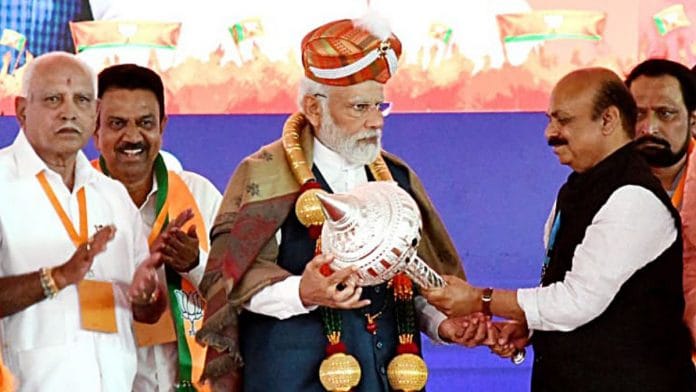The standout data point from the Karnataka verdict isn’t that the Congress has a clear majority and the BJP has lost its only redoubt in the south. It is, instead, the fact that the BJP has fallen to less than a half of the Congress. Chew on that number again. The almighty BJP, firing on two engines in the state and at the Centre, diminished to less than a half of the Congress.
This leaves many lessons and takeaways. Let us list the 10 most important here:
◆If you run a really bad state government, nothing can redeem you. Voters will then toss aside the charm of your national leaders, nationalism, polarisation, religion and definitely a partisan news media, no matter how it grovels to you.
◆Why didn’t the intense, personalised campaign by Prime Minister Narendra Modi work? Does it show a decline in his popularity? Hold your horses. Karnataka reminds us again that the voter makes a distinction between when Modi is himself on the ticket and when he seeks votes for others. He might still be able to hold a lamp-post election for the Lok Sabha. That’s why he wins Gujarat. He seeks the vote for himself there. Not in other states.
◆It follows that in a state, voters assess your local government’s performance. In the 2019 Lok Sabha elections, the BJP had swept 170 of the 224 assembly segments. The Congress and the JD(S), despite a pre-poll alliance, won merely 47 (36 Congress, 11 JD (S)). Today’s reversal, with the Congress and JD(S) nearly reaching 170 between them despite having no alliance, shows that Indian voters are too shrewd to put their emotions above rational expectations.
◆In their 10th year in power now, the Modi-Shah BJP have shown a stark inadequacy at replicating their Lok Sabha success in Vidhan Sabhas. They’ve suffered serial losses in the states, or settled for coalitions conceding much more ground to the partner than they would’ve liked. Check out Maharashtra, Haryana and Bihar for as long as Nitish’s wagon was tied to their engine.
We need to make a deeper analysis of the states they’ve decisively won by themselves. Uttar Pradesh and Assam, for example. In both, a local leader has risen, and each is quite capable of winning the election on his own. Both are the pre-eminent campaign leaders in their states. That does not follow the BJP high command’s script. Gujarat we explained earlier. Uttarakhand, along with some northeastern states, is an exception, but too small in the big picture.
◆The Modi-Shah BJP model of appointing lightweight chief ministers from New Delhi was frayed already. Karnataka is the rudest reminder of how unworkable it is. Except Manohar Lal Khattar in Haryana who carries on in his second term — albeit after conceding half his government to Dushyant Chautala — each one of these high command choices has produced a disaster. One, Devendra Fadnavis, has been reduced to deputy chief minister. Basavaraj Bommai is just the worst yet. The ‘high commandist’ parties usually detest their own strong state leaders. As did the BJP with Yeddiyurappa. That has devastated it in two elections, 2013 and 2023.
◆The model of governing the states from Delhi is fully broken. Would this BJP have a heart large enough to encourage more Yogis and Himantas to rise in the states? If so, it will make clear, early choices in Rajasthan and Chhattisgarh now. The party will also start rebuilding Shivraj Singh Chauhan’s stature instead of continuing to undermine it. This will need a fundamental shift in its style, temperament, and strategy. Does this BJP have it in it to accept the perils of becoming a one-leader party?
◆You can’t say polarisation doesn’t work. Or, the BJP would not have maintained its vote share despite its super-incompetent governance. But a reverse logic works too. A divisive appeal excites your faithful and likely also puts off those in the middle, the small percentage of uncommitted voters who matter in the end. The many disillusioned with the JD-S in this case preferred the Congress instead. The data so far tells us that the BJP’s vote share is mostly intact, the Congress’s has gone up by 5 per cent and that of the JD-S has declined by just over 5. It looks like a straight transfer. We can risk saying that when these voters looked for another choice, they didn’t want a divisive one. Polarisation, therefore, is a double edged sword. It can also put off enough Hindu voters to decimate you in a tight election.
◆This election will hopefully finish the Gowda family phenomenon that is the cynical, ideology-free, power-hungry JD(S). Over 25 years beginning in 1996 when patriarch H.D. Deve Gowda became prime minister, the party has leveraged its unprincipled number three status to often grab undeserved power. That business is over now. The Gowda dynasty is in terminal and sharp decline. It’s good for India, and even better for Karnataka.
◆The lesson for the Congress is similar to that for the BJP. That if you have strong state leaders, as in Siddaramaiah and D.K. Shivakumar, you can win despite the odds. The Gandhis’ ability to win states for you is enormously less than even Modi’s. But it’s unlikely that this will be accepted. Not if you have been watching Congress spokespersons all day giving credit for the win to Rahul Gandhi.
◆And finally, the evidence shows that in 21st-century India, Tipu Sultan does not matter. He may have been a good or awful guy more than two centuries ago. Abusing or adoring him won’t pay for my kid’s education now, get me a job, or put water in my tap. Leave him to historians and, you know what, for fake outrage on your warrior TV channels and in the living rooms of your New Lutyens.
Also read: How Karnataka loss could set back BJP’s ‘southern push’ for 2024 Lok Sabha polls






